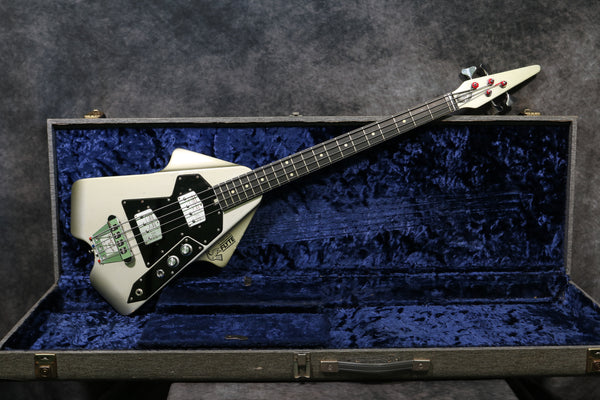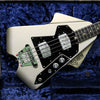Burns is most famous for the guitars he created before selling his business to Baldwin Piano and Organ Co. in 1965, including the Bison, Hank Marvin, and Jazz Split Sound (with the Wild Dog setting). But his career continued, off and on, until his death in 1998, and along the way, he left a number of curious instruments, including this stealth-shaped ca. 1976 Burns Flyte.
• Mahogany body with ‘ebonised’ maple neck
• Original hard case
• Short scale 30" (21 frets inc zero fret)
• 2 Humbuster pickups ( bridge pickup rewound)
• 3-way selector switch (neck-both-bridge, I think)
• Dynamic Tension tailpiece & bridge with individual adjustable saddles
• Silver finish
• Enclosed Schaller machine heads
• Lightweight - 6lbs 11oz / 3.04 kg.
| Condition | Very good 7.5/10 |
| Case | OHSC |
| Weight | 6lbs 11oz / 3.04 kg. |
Burns is most famous for the guitars he created before selling his business to Baldwin Piano and Organ Co. in 1965, including the Bison, Hank Marvin, and Jazz Split Sound (with the Wild Dog setting). But his career continued, off and on, until his death in 1998, and along the way, he left a number of curious instruments, including this stealth-shaped ca. 1976 Burns Flyte.
• Mahogany body with ‘ebonised’ maple neck
• Original hard case
• Short scale 30" (21 frets inc zero fret)
• 2 Humbuster pickups ( bridge pickup rewound)
• 3-way selector switch (neck-both-bridge, I think)
• Dynamic Tension tailpiece & bridge with individual adjustable saddles
• Silver finish
• Enclosed Schaller machine heads
• Lightweight - 6lbs 11oz / 3.04 kg.
| Condition | Very good 7.5/10 |
| Case | OHSC |
| Weight | 6lbs 11oz / 3.04 kg. |
Have a listen
Recorded in Logic. Use headphones for optimal sound quality.












































